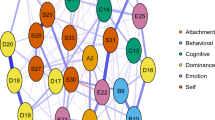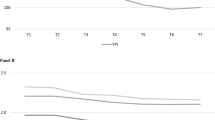Abstract
Objectives
Concerns about the value of features of psychopathy to explanations of offending may be driven by challenges with testing this relationship as opposed to the construct’s limited predictive validity. The current study introduced psychopathology network modeling as an analytic strategy capable of addressing these challenges through a more nuanced description of the structural and statistical association between features of psychopathy and offending. To provide more direct implications for criminological theory and research, this included examining whether within-individual changes in features of psychopathy were associated with within-individual change in offending.
Methods
Data on male and female young offenders from the Pathways to Desistance Study (n = 1354) were used to examine the association between features of psychopathy and offending versatility, as measured by the Youth Psychopathic Traits Inventory and the Self Report of Offending scale, respectively. Three network structures were modeled that separated the variance in the relationship between features of psychopathy and offending into between-subjects and within-individual networks.
Results
Between-subjects and within-individual analyses indicated that interpersonal and affective features of psychopathy were positively associated with offending versatility. The network approach indicated that remorselessness and manipulativeness were central features of psychopathy that were also associated with offending versatility. Remorselessness in particular helped bridge together conceptually distinct features of psychopathy.
Conclusions
Psychopathology network modeling illustrated the value of features of psychopathy to mainstream criminological theory and research. These features included interpersonal and affective deficits, which previously were identified as poor predictors of offending outcomes.



Similar content being viewed by others
Notes
We use the term “features of psychopathy” to describe individual traits that comprise the overarching construct and “psychopathy” to describe the co-occurrence of these features.
This is not to suggest that the only possible conclusion is that psychopathy is a network of co-occurring traits; there are multiple perspectives on the nature or structure of psychopathy and this paper does not provide an answer as to the relative importance of these different perspectives (see Lilienfeld et al. 2019).
Although structurally similar, the goldbricker function for the R package networktools (Jones, 2017) showed no suggestions for removing redundant nodes to reduce the network.
References
Andershed H, Kerr M, Stattin H, Levander S (2002) Psychopathic traits in non-referred youths: a new assessment tool. In: Blau E, Sheridan L (eds) Psychopaths: current international perspectives. Elsevier, Amsterdam, pp 131–158
Arnett JJ (2000) Emerging adulthood: a theory of development from the late teens through the twenties. Am Psychol 55:469–480
Bergman LR, Magnusson D (1997) A person-oriented approach in research on developmental psychopathology. Dev Psychopathol 9:291–319
Blonigen DM (2010) Explaining the relationship between age and crime: contributions from the developmental literature on personality. Clin Psychol Rev 30:89–100
Borsboom D, Cramer AOJ (2013) Network analysis: an integrative approach to the structure of psychopathology. Annu Rev Clin Psychol 9:91–121
Bouchard M, Malm A (2016) Social network analysis and its contribution to research on crime and criminal justice. Oxford Handbooks Online, pp 1–26
Bringmann LF, Ferrer E, Hamaker EL, Borsboom D, Tuerlinckx F (2018) Modeling nonstationary emotion dynamics in dyads using a time-varying vector-autoregressive model. Multivar Behav Res 53:293–314
Colins OF, Vermeiren R, De Bolle M, Broekaert E (2012) Self-reported psychopathic-like traits as predictors of recidivism in detained male adolescents. Crim Just Behav 39:1421–1435
Colins OF, Andershed H, Pardini DA (2015) Psychopathic traits as predictors of future criminality, intimate partner aggression, and substance use in young adult men. Law Hum Behav 39:547–558
Cooke DJ, Michie C (1997) An item response theory analysis of the hare psychopathy checklist-revised. Psychol Assess 9:3–14
Cooke DJ, Michie C (2001) Refining the construct of psychopathy: towards a hierarchical model. Psychol Assess 13:171–188
Cooke DJ, Michie C, Skeem J (2007) Understanding the structure of the psychopathy checklist–revised: an exploration of methodological confusion. Br J Psychiatry 190:s39–s50
Corrado RR, DeLisi M, Hart SD, McCuish EC (2015) Can the causal mechanisms underlying chronic, serious, and violent offending trajectories be elucidated using the psychopathy construct? J Crim Just 43:251–261
Cronbach LJ, Gleser GC (1953) Assessing similarity between profiles. Psychol Bull 50:456–473
DeLisi M (2016) Psychopathy as unified theory of crime. Palgrave Macmillan, New York
DeLisi M, Tostlebe J, Burgason K, Heirigs M, & Vaughn M (2018) Self-control versus psychopathy: A head-to-head test of general theories of antisociality. Youth Violence and Juvenile Justice 16:53–76
Edens JF, Campbell JS, Weir JM (2007) Youth psychopathy and criminal recidivism: a meta-analysis of the psychopathy checklist measures. Law Hum Behav 31:53–75
Epskamp S (2017) graphicalVAR: graphical VAR for experience sampling data (R package version 0.2.1) [Computer software manual]. Retrieved from http://CRAN.R-project.org/package=graphicalVAR
Epskamp S, Fried EI (2018a) A tutorial on regularized partial correlation networks. Psychol Methods 23(4):1–18
Epskamp S, Fried EI (2018b) Package ‘bootnet’. Retrieved from https://cran.r-project.org/web/packages/bootnet/bootnet.pdf. Accessed 15 Mar 2020
Epskamp S, Costantini G, Haslbeck J, Cramer AOJ, WaldropLJ, Schmittmann VD, Borsboom D (2017) qgraph: graph plotting methods, psychometric data visualization and graphical model estimation (R Package version 1.5) [Computer software manual]. Retrieved from https://cran.r-project.org/web/packages/qgraph/qgraph.pdf
Epskamp S, Borsboom D, Fried EI (2018a) Estimating psychological networks and their accuracy: a tutorial paper. Behav Res Methods 50:195–212
Epskamp S, van Borkulo CD, van der Veen DC, Servaas MN, Isvoranu AM, Riese H, Cramer AO (2018b) Personalized network modeling in psychopathology: the importance of contemporaneous and temporal connections. Clin Psychol Sci 6:416–427
Epskamp S, Waldorp LJ, Mõttus R, Borsboom D (2018c) Discovering psychological dynamics: the Gaussian graphical model in cross-sectional and time-series data. Multivar Behav Res 1–29
Fanti KA, Kyranides MN, Lordos A, Colins OF, Andershed H (2018) Unique and interactive associations of callous-unemotional traits, impulsivity and grandiosity with child and adolescent conduct disorder symptoms. J Psychopathol Behav Assess 40:40–49
Farrington DP (2005) The importance of child and adolescent psychopathy. J Abnorm Child Psychol 33:489–497
Freeman L (1977) A set of measures of centrality based on betweenness. Sociometry 40:35–41
Fox BH, Jennings WG, & Farrington DP (2015) Bringing psychopathy into developmental and life-course criminology theories and research. J Crim Justice 43:274–289
Gottfredson M, Hirschi T (1990) A general theory of crime. Stanford University Press, Stanford, CA
Gottfried ED, Harrop TM, Anestis JC, Venables NC, Sellbom M (2019) An examination of triarchic psychopathy constructs in female offenders. J Pers Assess 101:455–467
Hare RD, Neumann GS (2010) The role of antisociality in the psychopathy construct: comment on Skeem and Cooke 2010. Psychol Assess 22:446–454
Hart SD (1998) The role of psychopathy in assessing risk for violence: conceptual and methodological issues. Legal Criminol Psychol 3:121–137
Hart SD, Cook AN (2012) Current issues in the assessment and diagnosis of psychopathy (psychopathic personality disorder). Neuropsychiatry 2:497–508
Huizinga D, Esbensen FA, Weiher AW (1991) Are there multiple paths to delinquency? J Crim Law Criminol 82:83–118
Kennealy PJ, Skeem JL, Walters GD, Camp J (2010) Do core interpersonal and affective traits of PCL-R psychopathy interact with antisocial behavior and disinhibition to predict violence? Psychol Assess 22:569–580
Knoke D, Yang S (2008) Social network analysis, 2nd edn. Sage, Thousand Oaks
Kreis MF, Cooke DJ, Michie C, Hoff HA, Logan C (2012) The comprehensive assessment of psychopathic personality (CAPP): content validation using prototypical analysis. J Pers Disord 26:402–413
Laub JH, Sampson RJ (2003) Shared beginnings, divergent lives: delinquent boys to age 70. Harvard University Press, Massachusetts
Lee SS (2018) Multidimensionality of youth psychopathic traits: validation and future directions. J Psychopathol Behav Assess 40:86–92
Leistico AMR, Salekin RT, DeCoster J, Rogers R (2008) A large-scale meta-analysis relating the Hare measures of psychopathy to antisocial conduct. Law Hum Behav 32:28–45
Lilienfeld SO (2018) The multidimensional nature of psychopathy: five recommendations for research. J Psychopathol Behav Assess 40:79–85
Lilienfeld SO, Watts AL, Murphy B, Costello TH, Bowes SM, Smith SF et al (2019) Personality disorders as emergent interpersonal syndromes: psychopathic personality as a case example. J Pers Disord 33:577–622
Loeber R, Le Blanc M (1990) Toward a developmental criminology. Crime Just 12:375–473
McCuish EC, Lussier P (2018) A developmental perspective on the stability and change of psychopathic personality traits across the adolescence–adulthood transition. Crim Justice Behav 45:666–692
McElroy E, Shevlin M, Murphy J, McBride O (2018) Co-occurring internalizing and externalizing psychopathology in childhood and adolescence: a network approach. Eur Child Adolesc Psychiatry 27:1–9
McGloin JM, Kirk DS (2010) Social network analysis. In: Piquero AR, Weisburd D (eds) Handbook of quantitative criminology. Springer, New York, pp 209–224
McCuish E, Bouchard M, Beauregard E, & Corrado R (2019) A network approach to understanding the structure of core symptoms of psychopathic personality disturbance in adolescent offenders. J Abnorm Child Psychol 47:1467–1482
Mulvey E (2013) Research on Pathways to Desistance [Maricopa County, AZ and Philadelphia County, PA]: Subject Measures, 2000–2010. ICPSR29961-v2. Ann Arbor, MI: Inter-university Consortium for Political and Social Research [distributor], 01 July 2013
Nagin D, & Paternoster R (2000) Population heterogeneity and state dependence: State of the evidence and directions for future research. J Quant Criminol 16:117–144
Neumann CS, Hare RD, Newman JP (2007) The super-ordinate nature of the Psychopathy Checklist-Revised. J Pers Disord 21:102–117
Olver ME, Lewis K, Wong SC (2013a) Risk reduction treatment of high-risk psychopathic offenders: the relationship of psychopathy and treatment change to violent recidivism. Pers Disorders Theory Res Treat 4:160–167
Olver ME, Neumann CS, Wong SC, Hare RD (2013b) The structural and predictive properties of the Psychopathy Checklist-Revised in Canadian Aboriginal and non-Aboriginal offenders. Psychol Assess 25:167–179
Opsahl T, Agneessens F, Skvoretz J (2010) Node centrality in weighted networks: generalizing degree and shortest paths. Soc Netw 32:245–251
Preszler J, Marcus DK, Edens JF, McDermott BE (2018) Network analysis of psychopathy in forensic patients. J Abnorm Psychol 127:171–182
R Core Team (2017) R: A language and environment for statistical computing. R Foundation for Statistical Computing, Vienna
Ridder KA, Kosson DS (2018) Investigating the components of psychopathic traits in youth offenders. J Psychopathol Behav Assess 40:60–68
Robins RW, Fraley RC, Roberts BW, Trzesniewski KH (2001) A longitudinal study of personality change in young adulthood. J Pers 69:617–640
Salekin RT (2016) Psychopathy in childhood: toward better informing the DSM–5 and ICD-11 conduct disorder specifiers. Pers Disorders Theory Res Treat 7:180–191
Salekin RT, Andershed H, Batky BD, Bontemps AP (2018) Are callous unemotional (CU) traits enough? Journal of Psychopathology and Behavioral Assessment 40:1–5
Sewall LA, Olver ME (2019) Psychopathy and treatment outcome: results from a sexual violence reduction program. Pers Disorders Theory Res Treat 10:59–69
Skeem JL, Cooke DJ (2010) Is criminal behavior a central component of psychopathy? Conceptual directions for resolving the debate. Psychol Assess 22:433–445
Stekhoven DJ, Bühlmann P (2012) MissForest—non-parametric missing value imputation for mixed-type data. Bioinformatics 28:112–118
Sweeten G, Pyrooz DC, Piquero AR (2013) Disengaging from gangs and desistance from crime. Just Q 30:469–500
Vahl P, Colins OF, Lodewijks HP, Markus MT, Doreleijers TA, Vermeiren RR (2014) Psychopathic-like traits in detained adolescents: clinical usefulness of self-report. Eur Child Adolesc Psychiatry 23:691–699
Verschuere B, van Ghesel Grothe S, Waldorp L, Watts AL, Lilienfeld SO, Edens JF et al (2018) What features of psychopathy might be central? A network analysis of the psychopathy checklist-revised (PCL-R) in three large samples. J Abnorm Psychol 127:51–65
Walters GD (2004) The trouble with psychopathy as a general theory of crime. Int J Offender Ther Comp Criminol 48:133–148
Walters GD (2012) Psychopathy and crime: testing the incremental validity of PCL-R-measured psychopathy as a predictor of general and violent recidivism. Law Hum Behav 36:404–412
Walters GD (2015) A multi-wave cross-lagged regression analysis of the youth psychopathic traits inventory and self-reported offending. J Crim Just 43:327–336
Wasserman S, Faust K (1994) Social network analysis: methods and applications. Cambridge University Press, Cambridge
Author information
Authors and Affiliations
Corresponding author
Additional information
Publisher's Note
Springer Nature remains neutral with regard to jurisdictional claims in published maps and institutional affiliations.
Electronic supplementary material
Below is the link to the electronic supplementary material.
Rights and permissions
About this article
Cite this article
McCuish, E., Bouchard, M. & Beauregard, E. A Network-Based Examination of the Longitudinal Association Between Psychopathy and Offending Versatility. J Quant Criminol 37, 693–714 (2021). https://doi.org/10.1007/s10940-020-09462-w
Published:
Issue Date:
DOI: https://doi.org/10.1007/s10940-020-09462-w




